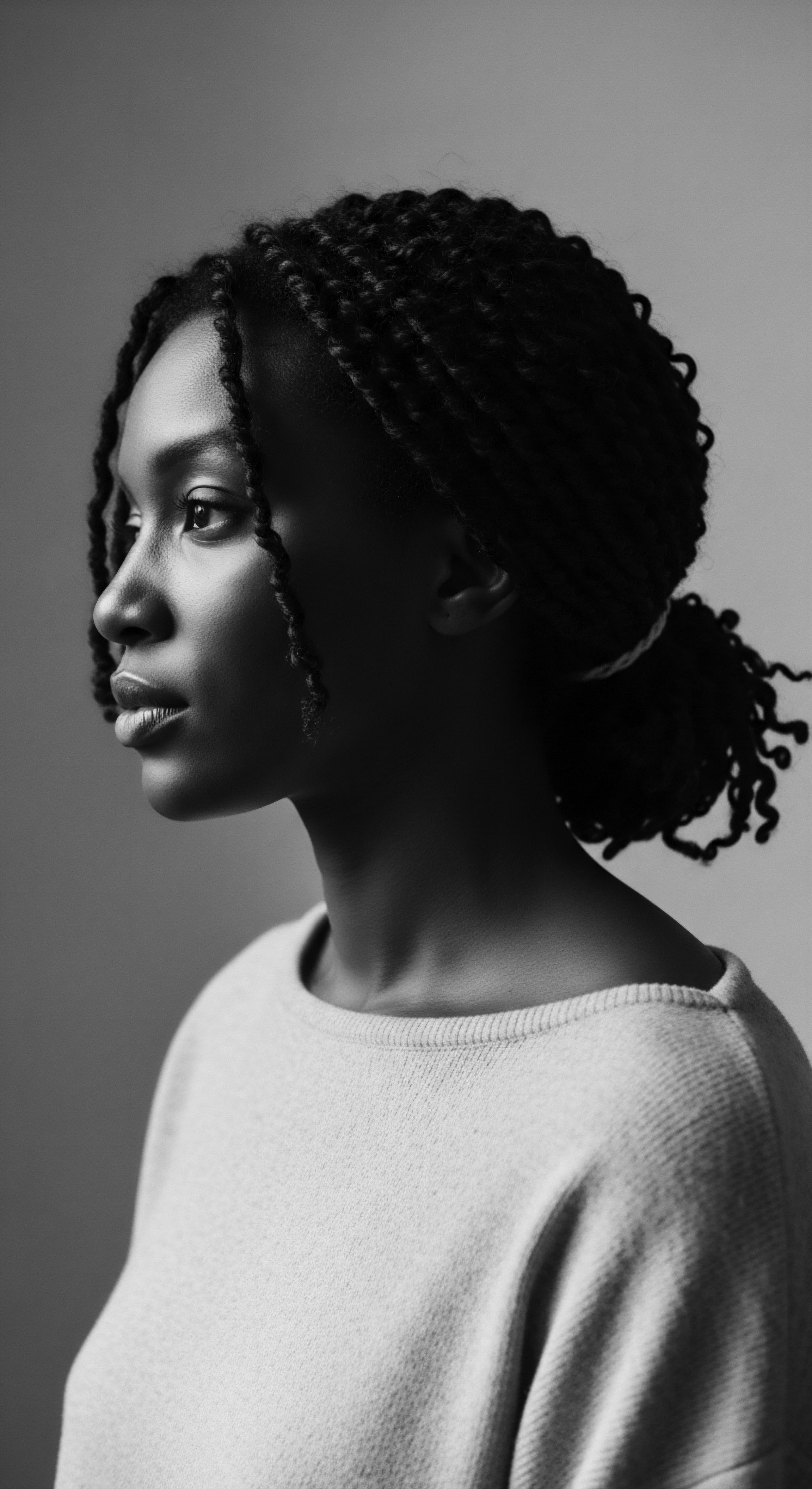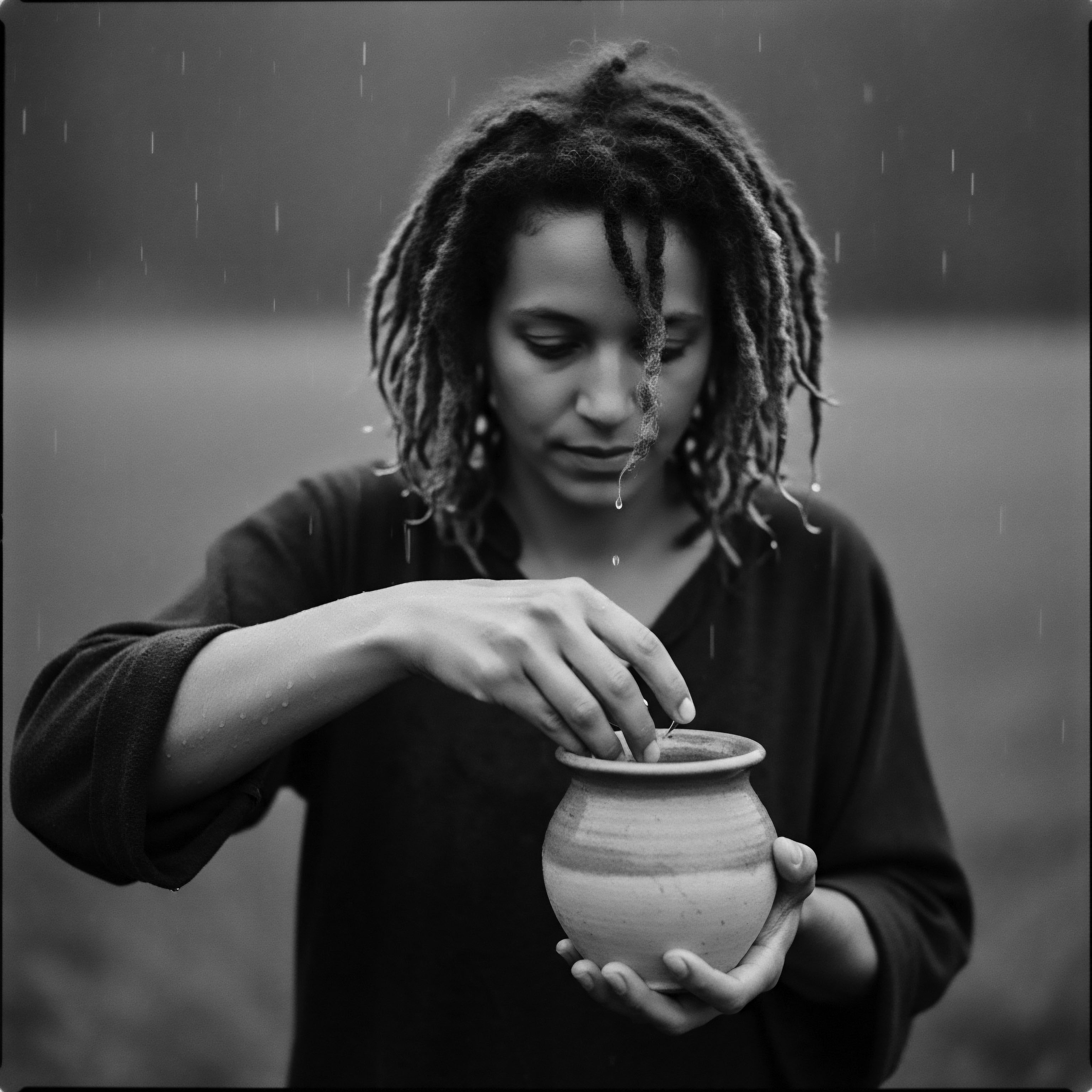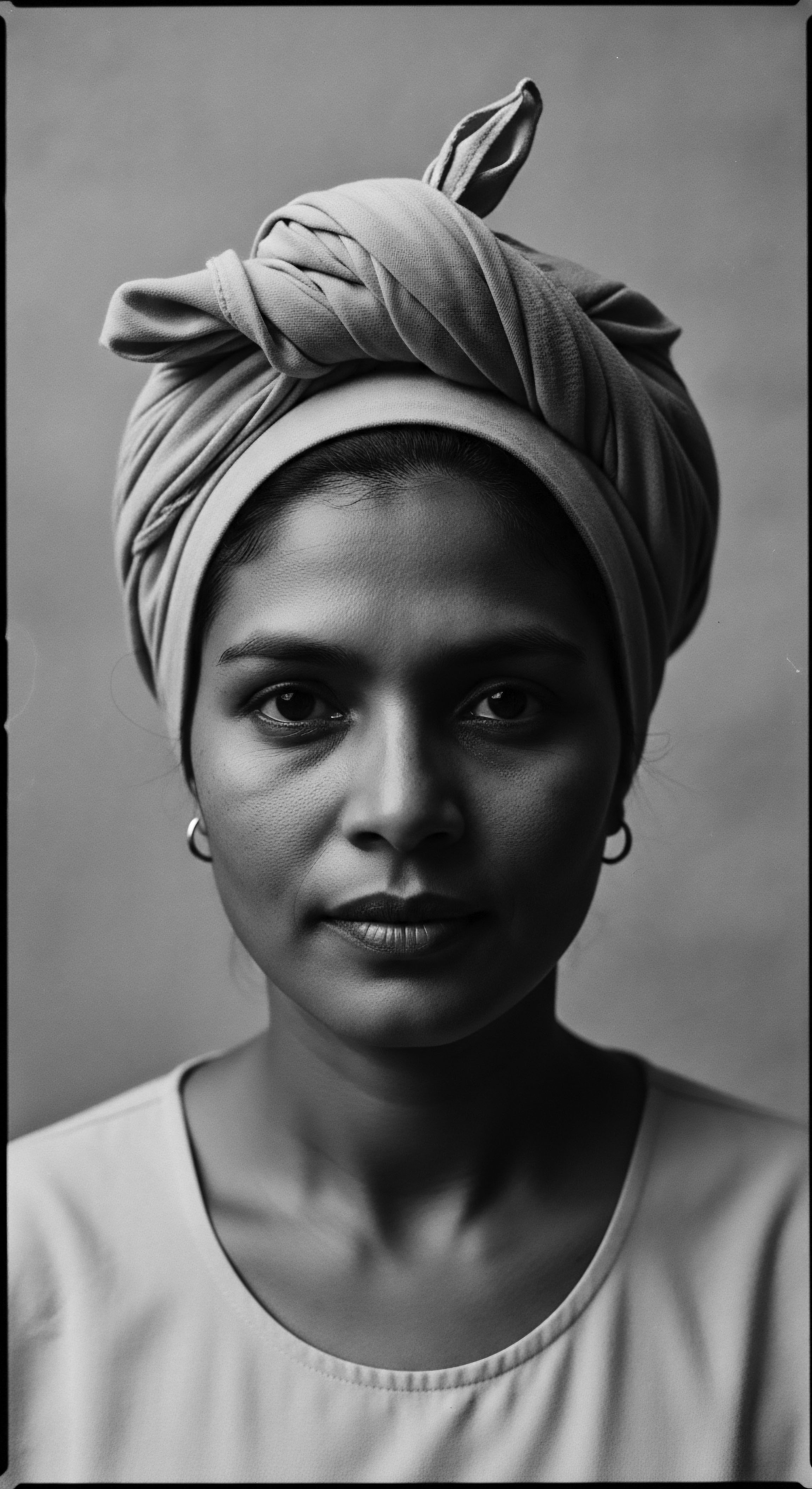
Roots
There exists a profound memory within each coil and kink, a whisper of soil and sun, a lineage stretching back through generations. It is a memory of hands tending, of natural elements providing, of care interwoven with identity. For those with textured hair, this connection to the past is not a quaint notion; it is the very pulse of being.
Within this living archive, a question gently arises ❉ Can Rhassoul clay, born from the ancient Moroccan earth, truly stand in place of the familiar lathers of today for the moisture needs of our strands? This inquiry invites us into a deeper consideration of what cleansing truly signifies for our unique hair, moving beyond mere product application to a dialogue with our shared textured hair heritage .
To understand Rhassoul clay’s place, we must first recognize the intrinsic blueprint of textured hair. Its distinct structure, unlike its straighter counterparts, carries a story of resilience and particular requirements. The elliptical shape of the follicle, the often raised cuticle layers, and the very path a strand takes from scalp to tip all contribute to its inherent dryness and delicate nature. This is not a flaw, but a characteristic that has shaped generations of care practices.
Ancestral wisdom, often passed through oral tradition and lived experience, recognized these needs long before modern microscopy. They understood that severe stripping agents, though unknown by that name, would harm the hair’s very life force.
Rhassoul clay offers a unique historical continuity in hair care, connecting contemporary cleansing to ancient practices that respected textured hair’s intrinsic nature.

Hair’s Ancestral Anatomy
The individual strand of textured hair is a testament to natural artistry, its curves and spirals a masterpiece of biological design. Each curl presents a bend, a point where the cuticle layers can slightly lift, allowing moisture to escape more readily. This structural reality makes moisture retention a central tenet of traditional care. Our ancestors, across diverse African communities and diasporic settlements, devised intricate methods to preserve this moisture.
They relied on natural cleansers and emollients drawn directly from their environments, substances that worked with the hair’s design, not against it. The historical record suggests a profound intuitive understanding of hair’s anatomy, long before scientific terms like “cortex” or “medulla” were part of any lexicon.

Unearthing Traditional Terms for Hair Types
The classifications we use today, like 3C or 4A, are modern constructs, useful perhaps for product marketing, but they lack the ancestral resonance. Older communities possessed their own descriptive terms, often tied to observation of nature or societal roles, that spoke to the variety of hair textures. For instance, in some West African cultures, hair might be described by its likeness to certain plant fibers or animal fleeces, subtly conveying its texture and care needs.
These terms were not about a numeric grade but about a holistic appreciation of hair’s form within its environment, often linked to its care and styling. Understanding these traditional descriptors, even if fragments remain, connects us to a deeper lexicon of textured hair heritage .
- Kinky Coily Hair ❉ Often described with analogies to sheep’s wool or tightly coiled vines in West African traditions.
- Curly Wavy Hair ❉ Sometimes likened to flowing water patterns or the gentle undulations of certain grasses.
- Looser Curls ❉ Descriptions might reference softer plant fibers or natural spirals found in shells.

Geological Roots of Rhassoul Clay
Rhassoul clay, also known as Ghassoul, holds a place in history that transcends its current beauty market popularity. It hails specifically from the Moulouya Valley in the Moroccan Atlas Mountains, where it has been mined and used for over 12 centuries by North African women. This isn’t a new discovery; it is a rediscovery of an ancestral staple. Its unique composition, rich in minerals such as magnesium, silica, potassium, and calcium, provides its distinct cleansing and conditioning properties.
Unlike many modern cleansers that rely on harsh sulfates, Rhassoul clay’s action is one of absorption and ion exchange. It draws out impurities and excess oils, while simultaneously imparting beneficial minerals and maintaining the hair’s natural moisture balance, a balance often disturbed by conventional shampoos. This ancient earth offers a gentle approach, one that aligns with the protective care textured hair has always required. A study by the International Journal of Cosmetic Science noted the clay’s high capacity for ion exchange, contributing to its cleansing power while conditioning the skin and hair (Firoozeh et al.
2018). This scientific observation echoes the long-held ancestral understanding of its purifying yet mild nature.

Ritual
The path of hair care for textured strands has always been a ritual, a thoughtful engagement with self and communal identity. It speaks of a time when beauty practices were intertwined with spiritual grounding, familial bonding, and resistance. Rhassoul clay, in its historical application, was not merely a product; it was a central element in these profound daily and weekly observances. Its preparation, often involving a simple mixing with water or rosewater, became a meditative act, a moment of presence.
This contrasts sharply with the hurried, often disembodied nature of modern wash days. Can Rhassoul clay therefore offer a return to this more mindful engagement with our hair, particularly in its capacity to preserve moisture?

Ancient Cleansing Methods
For centuries, the women of North Africa, particularly those with naturally coiling and curling hair, relied on Rhassoul clay for their hair and body cleansing. Its use was deeply embedded in their cultural practices, particularly in the hammam ritual. The hammam, or traditional bathhouse, was a social and cleansing space, and the application of Rhassoul clay was a cornerstone of its hair care regimen. This process was a far cry from the quick lather and rinse of today’s shampoos.
The clay would be massaged gently into the hair, left to sit, allowing its minerals to interact with the scalp and strands, and then rinsed thoroughly. This method respected the hair’s need for gentle handling and minimal manipulation, thereby reducing friction and preserving natural oils – critical for retaining moisture in textured hair . The slow, deliberate nature of this practice was in itself a protective styling technique.

Why Did Ancestral Practices Favor Gentle Cleansing?
Ancestral practices, particularly those involving natural clays, favored gentleness because the very structure of textured hair demands it. Unlike straight hair, which allows natural sebum to easily travel down the shaft, the twists and turns of coils and kinks make this journey difficult. This leaves textured hair naturally prone to dryness. Harsh cleansers strip away the precious oils that manage to coat the strands, leaving hair vulnerable to breakage and moisture loss.
Traditional methods, like those using Rhassoul clay, understood this delicate balance. They aimed to purify without depleting, to refresh without stripping, thereby supporting the hair’s natural moisture barrier, a practice crucial for the health and vitality of hair passed down through generations.

Rhassoul’s Role in Protective Styling
Protective styles, from elaborate cornrows to simple twists, have always been more than just aesthetic choices for textured hair; they are a legacy of preservation and cultural expression. When hair is prepared with harsh cleansers, it becomes brittle and difficult to manipulate into these styles without breakage. Rhassoul clay’s conditioning properties, inherited from its mineral content, leave the hair soft, supple, and less prone to tangling. This makes it an ideal preparatory step for protective styling, a practice that has spanned centuries.
A historical example of this comes from various African diasporic communities, where natural clay mixtures or plant-based cleansers were utilized to prepare hair before braiding or twisting, allowing for smoother handling and reducing the stress on individual strands. This tradition demonstrates a deep understanding of maintaining hair health while it is styled and protected for extended periods, preserving the integrity of the textured hair heritage .
| Aspect Cleansing Mechanism |
| Rhassoul Clay (Ancestral Use) Adsorption and ion exchange; lifts impurities, leaves natural oils. |
| Traditional Shampoo (Modern Use) Surfactant-based; creates lather, often strips natural oils. |
| Aspect Moisture Impact |
| Rhassoul Clay (Ancestral Use) Conditions, imparts minerals, aids moisture retention. |
| Traditional Shampoo (Modern Use) Can strip moisture, leaving hair feeling dry or "squeaky clean." |
| Aspect Mineral Content |
| Rhassoul Clay (Ancestral Use) Rich in magnesium, silica, potassium, calcium from the earth. |
| Traditional Shampoo (Modern Use) Often synthetic formulations; minimal natural mineral contribution. |
| Aspect Application Experience |
| Rhassoul Clay (Ancestral Use) Mindful, often part of a longer ritual, gentle massage. |
| Traditional Shampoo (Modern Use) Quick lather, rinse; focused on speed and foam. |
| Aspect Hair Feel Post-Wash |
| Rhassoul Clay (Ancestral Use) Soft, detangled, conditioned, with natural slip. |
| Traditional Shampoo (Modern Use) Can feel rough, tangled, or in need of immediate conditioning. |
| Aspect The ancestral approach using Rhassoul clay prioritized preservation, aligning with the intrinsic needs of textured hair across generations. |

Relay
The dialogue between ancient wisdom and contemporary understanding offers a fertile ground for exploring the capabilities of Rhassoul clay in modern textured hair care. Moving beyond anecdotal evidence, scientific inquiry now sheds light on what our ancestors knew instinctively ❉ certain natural elements possess properties uniquely suited to our hair’s structure and moisture needs. This is not about choosing one over the other, but about drawing parallels, deepening our comprehension, and honoring a lineage of hair knowledge that has, for too long, been overlooked or dismissed in mainstream narratives. The question of Rhassoul clay replacing traditional shampoos for textured hair moisture becomes a compelling point of reflection on this continuum of care.

Decoding Clay’s Moisture Science
The efficacy of Rhassoul clay in supporting moisture for textured hair lies in its unique mineral composition and its swelling properties. When hydrated, the clay transforms into a smooth, unctuous paste. This paste possesses an ionic charge that attracts and binds to impurities, excess sebum, and product buildup without stripping the hair’s essential lipids. Unlike detergents found in many shampoos, which can disrupt the delicate cuticle layer, Rhassoul clay works by gently absorbing and lifting these unwanted elements.
This leaves the natural moisture barrier of the hair intact. Moreover, the minerals within the clay, particularly magnesium, are believed to contribute to hair elasticity and strength, reducing breakage and thereby aiding in moisture retention. This gentle yet thorough cleansing action is precisely what textured hair, prone to dryness, requires. It provides a cleanse that is inherently conditioning, a concept deeply rooted in ancestral practices that valued replenishment alongside purification.
Rhassoul clay’s cleansing mechanism, rooted in mineral-rich absorption, aligns perfectly with textured hair’s moisture needs by preserving its natural oils and delicate structure.

Traditional African Hair Preservation
In various parts of Africa, the preservation of hair, especially in regions with arid climates, was a matter of survival for the strands. Communities utilized naturally occurring substances and elaborate care rituals to protect hair from environmental stressors. For example, in parts of West Africa, certain clays and plant extracts were used not just for cleansing but also as protective coatings or masks to seal in moisture and offer a barrier against harsh sun and wind. These practices were meticulous, understanding that moisture, once introduced, had to be carefully guarded.
While not always Rhassoul clay specifically, the principle of using earth-derived materials for hair health and preservation runs deep within the African textured hair heritage . This ancestral blueprint for moisture preservation offers a compelling counter-narrative to the modern idea that only complex synthetic formulations can provide adequate hair care.

Why do Modern Products Sometimes Fail Textured Hair?
Many modern conventional shampoos, designed for a broad consumer base, often prioritize powerful degreasing agents and high lather. While effective for straight hair, these ingredients can be overly aggressive for textured hair. They indiscriminately strip away natural oils (sebum) that are vital for maintaining moisture and pliability in coiled and kinky strands. The result is often hair that feels brittle, dry, and more susceptible to breakage.
This contrasts with the ancestral understanding that cleansing for textured hair must be a nurturing act, one that removes impurities while safeguarding its inherent hydration. The historical wisdom recognizes that preserving the hair’s natural equilibrium is paramount, a lesson often missed by formulations that prioritize superficial cleanliness over long-term hair health and moisture balance.
- Ingredient Consciousness ❉ Understanding natural alternatives to harsh detergents, acknowledging their historical efficacy.
- Moisture Prioritization ❉ Shifting focus from “squeaky clean” to hydrated and pliable strands.
- Scalp Health Synergy ❉ Recognizing the interconnectedness of scalp and hair vitality, as understood in ancestral holistic care.

Case Study ❉ Moroccan Hair Care Practices
The enduring use of Rhassoul clay in Morocco provides a compelling, living case study of its effectiveness. Moroccan women, with a wide spectrum of textured hair, have traditionally relied on this clay for generations as their primary hair cleanser and conditioner. This practice has not merely persisted; it has been foundational to their hair health and beauty regimens. Unlike the common experience with modern shampoos where a separate conditioner is almost always necessary to restore moisture and detangle, Rhassoul clay inherently offers both cleansing and conditioning properties.
Its capacity to soften and detangle hair is often cited as a primary benefit, allowing for easier manipulation and styling, which in turn reduces mechanical damage and breakage. This continuous, successful historical application of Rhassoul clay serves as a powerful anecdotal validation, showing that a naturally derived, single ingredient can indeed stand as a holistic alternative to a multi-step conventional shampoo and conditioner system for textured hair moisture needs. This is not simply about replacing a product; it reflects a return to a more integrated and ancestral approach to care, where simplicity often held the greatest efficacy (Tijani et al. 2012).
| Era/Context Ancient North Africa (e.g. Berber traditions) |
| Primary Cleansing Agents Rhassoul Clay, saponaria (soapwort) plant extracts, various herbal infusions. |
| Era/Context Pre-Colonial West Africa |
| Primary Cleansing Agents Ash, fermented plant ingredients, specific local clays, natural oils for cleansing massage. |
| Era/Context Early African Diaspora (e.g. Caribbean, Americas) |
| Primary Cleansing Agents Castile soap (when available), lye soap, herbal rinses, natural clays, cornstarch pastes. |
| Era/Context Mid-20th Century (Post-Relaxer Era) |
| Primary Cleansing Agents Sulfate-rich shampoos, often highly alkaline, designed for straightened hair. |
| Era/Context Late 20th/Early 21st Century (Natural Hair Movement) |
| Primary Cleansing Agents Sulfate-free shampoos, co-washes, low-poo, and rediscovery of natural cleansers like Rhassoul clay. |
| Era/Context The lineage of textured hair care reveals a consistent leaning towards gentler, natural cleansers for moisture, a cyclical return to ancestral wisdom. |

Reflection
The journey through Rhassoul clay’s potential as a shampoo alternative for textured hair moisture has been more than a technical exploration; it has been a profound meditation on the enduring spirit of our strands, a quiet conversation with the past. It shows that the answer to modern hair concerns often lies not in manufactured novelty, but in returning to the timeless wisdom embedded in our textured hair heritage . The question of whether this ancient earth can truly replace conventional lathers extends beyond mere function. It touches upon a deeper desire for connection, for authenticity, for practices that align with a sense of self rooted in ancestral ways.
For those of us with coils, kinks, and curls, our hair has always been more than just adornment. It has been a symbol of identity, a canvas for expression, a testament to resilience through centuries of imposed standards and self-discovery. To choose Rhassoul clay is to choose a piece of that legacy, a tangible link to a time when care was intuitive, when ingredients were drawn directly from the earth, and when beauty rituals were acts of self-preservation and communal solidarity.
It whispers of a more gentle way, a respectful way, a way that prioritizes the intrinsic moisture and vitality of our hair. It is a reminder that the true soul of a strand lies not only in its present health but in its ancestral echoes, forever guiding our path to true radiance.

References
- Firoozeh, M. Vian, L. & Cherkaoui, R. (2018). Rheological and Physicochemical Properties of Moroccan Ghassoul Clay. International Journal of Cosmetic Science, 40(2), 176-184.
- Tijani, A. El Alami, A. Cherkaoui, R. & Vian, L. (2012). Chemical and mineralogical characterization of Ghassoul from Jebel Ghassoul (Morocco). Clay Minerals, 47(3), 361-370.
- Byrd, A. D. & Tharps, L. L. (2001). Hair Story ❉ Untangling the Roots of Black Hair in America. St. Martin’s Press.
- Opoku-Mensah, P. (2016). Hair ❉ A Cultural History. Bloomsbury Academic.
- Diaw, N. L. & Khodabakhsh, Z. (2014). Traditional African Hair Care Practices. Journal of Black Studies, 45(6), 467-482.
